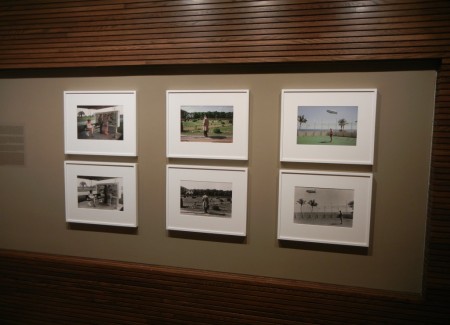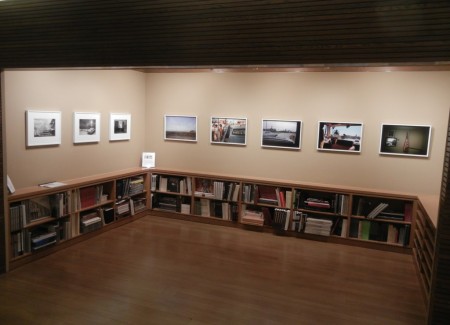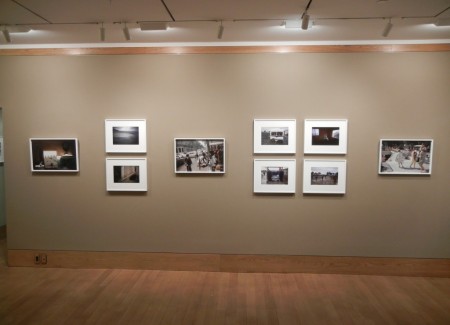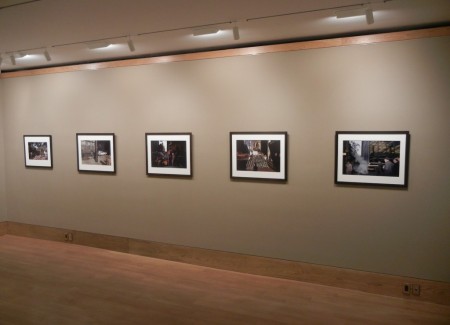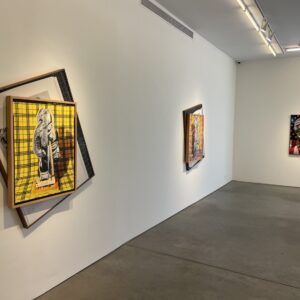JTF (just the facts): A total of 47 black and white and color photographs, variously framed and matted, and hung against light brown walls in the main gallery space, the book alcove, and the back transition gallery. The works in the show were made between 1962 and 1976. The 17 black and white images are a mix of vintage gelatin silver prints and modern archival pigment prints, sized between 9×13 and 11×15. No edition information was available for the vintage prints; the pigment prints are available in editions of 25. The 30 color images are a mix of modern archival pigment prints, vintage chromogenic prints and vintage dye transfer prints, sized between 9×14 and 27×40 (or reverse). No edition information was available for the vintage prints; edition sizes for the modern prints are variously 10, 15, 20, or 25. (Installation shots at right.)
Comments/Context: Joel Meyerowitz seems to having a bit of a resurgence these days. A new two volume retrospective book, a European museum show, a couple of lifetime achievement awards, and now, in conjunction with joining the stable at Howard Greenberg, a two part career survey at the gallery. It feels like a consolidating, summing up moment for the influential American photographer.
This show digs back into the archive and tells the story of Meyerowitz’ early career. It finds him moving back and forth between black and white and color, testing the affinities and limits of both approaches. During this time period, there is a slow evolution from a focus on street photography (particularly in New York) to a broader look at the effects of color, in locations all around the world. But this transition doesn’t happen like a turning on a light switch; it’s more like a faucet, starting with a trickle of ideas that eventually overwhelms the previous style. Many of Meyerowitz’ early street scenes center on a single event: a woman in a coffee shop, a Times Square ticket seller obscured by the window grill, the splash of a red dress and gauzy hat at Easter, a cluster of women in white pumps standing in a doorway, the kiss of a hand in Central Park. A few of the pictures then start to become more complex and cinematic: a woman being thrown into a convertible, a gathering of people on a front stoop all looking in different directions, the blown hair of couples in Dallas, a fallen man in Paris surrounded by a chaotic group of gawkers.
One wall of the exhibit shows pairs of images in black and white and color, taken seconds apart. They are evidence of Meyerowitz’ changing mind set, and the creeping influence of color on his work. The astro turf swimsuit man standing under a blimp is far more puzzling in color than in black and white. Slowly, the images seem to turn on the play of color rather than the coalescing of a decisive moment: the blue brushes of a Bulgarian car wash, a shadowy green room with an American flag, a pile of grey police barriers, a pair of camel hair coats on the sidewalk. And once again, the compositions increase in complexity, this time balancing many color fields: a bikini clad body, a blue car, and the long white line of a curb, snug in a mess of Florida telephone poles, a shapely bus driver’s leg in white boots in warm yellow sun, a lion balanced by a photo-taker in a car, taken through the dark frame of another car window. The few vintage dye transfers on view tint these kinds of scenes with a more saturated, richer color, both darker and more tactile.
I liked the sense of experimentation that is found in this selection of pictures – they’re not all greatest hits or best shots. Whether it was a woman behind a projection screen, the flowers in a window of a trailer, or a jumping poodle, Meyerowitz was honing his craft and internalizing the nature of photographic color. Overall, this show is a solid sampler of work from the artist’s formative years, and sets the stage for Part II of the exhibit coming in December.
Collector’s POV: The works in the show are priced between $5000 and $40000. Meyerowitz’ work is routinely available in the secondary markets, particularly prints of his 1970s images made in large editions (75 or even 100). Prices have typically ranged from $1000 to $14000, mostly on the lower end of that range.

